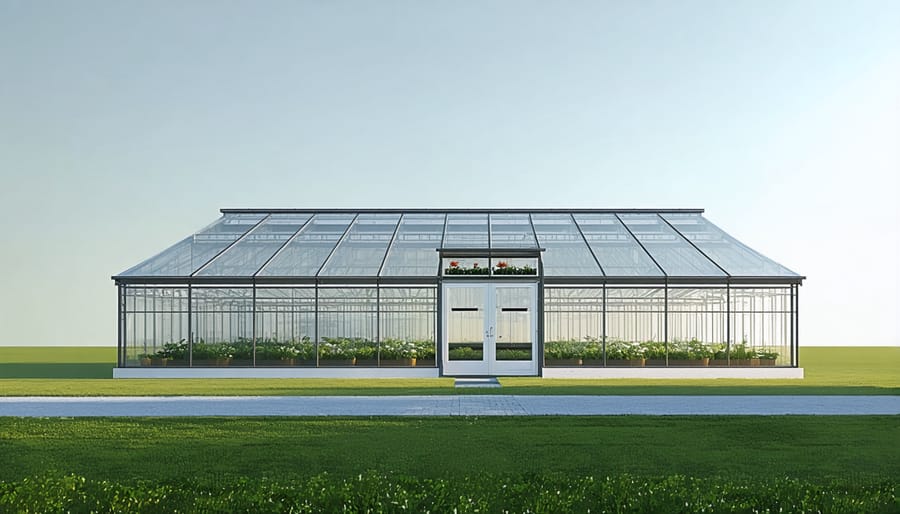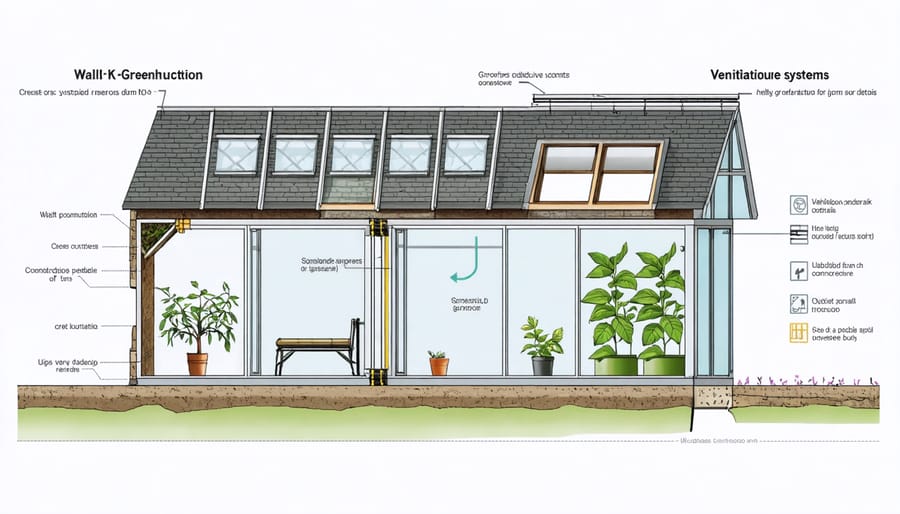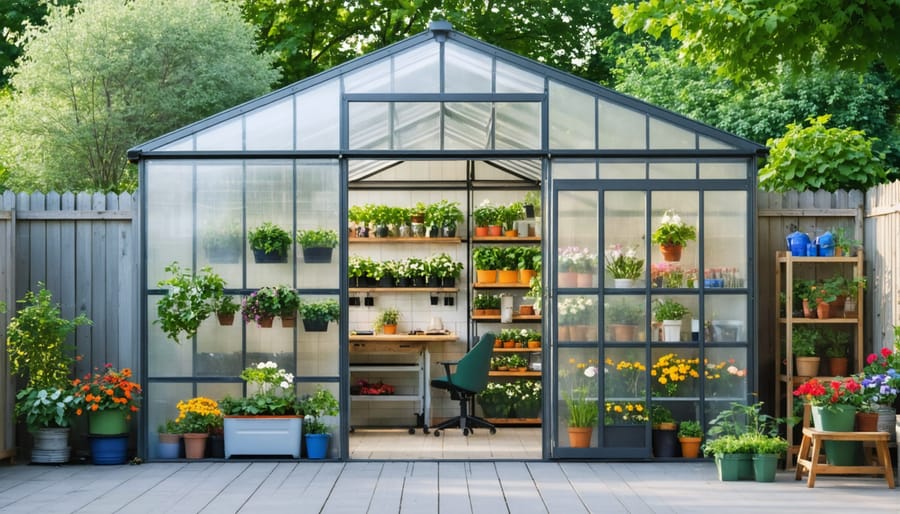Transform your outdoor space into a year-round gardening haven by combining a practical storage shed with a sunlit greenhouse. Modern shed-greenhouse combinations maximize limited garden space while creating distinct zones for both tool storage and plant cultivation. These innovative structures merge the functionality of a traditional garden shed with the growing potential of a greenhouse, offering a cost-effective solution for serious gardeners and homeowners alike.
The strategic fusion of these two essential garden structures delivers multiple benefits: protected growing space for tender plants, organized storage for tools and equipment, and reduced construction costs compared to building separate units. Whether you’re an experienced DIY enthusiast or planning to work with a contractor, thoughtful shed-greenhouse combo plans provide the blueprint for creating an efficient, dual-purpose structure that enhances your property’s value and extends your growing season.
This comprehensive guide explores essential design considerations, material choices, and construction techniques for building a successful shed-greenhouse combination that meets both your storage and gardening needs. From selecting the optimal orientation for maximum sunlight to incorporating clever storage solutions, we’ll walk through every aspect of planning and building your perfect garden workspace.
Smart Design Considerations for Your Combo Structure
Optimal Orientation and Layout
Proper orientation and layout are crucial factors in creating a successful shed and greenhouse combination. The key to optimal greenhouse design starts with positioning the structure to maximize sunlight exposure. For most locations in the Northern Hemisphere, orient the greenhouse portion facing south or southeast to capture the most sunlight throughout the day.
Consider allocating about 60% of the space to storage and 40% to the greenhouse area, though this ratio can be adjusted based on your specific needs. The greenhouse section should be positioned where it won’t be shadowed by nearby trees or buildings, while the storage area can be more flexible in its placement.
Create distinct pathways between both sections, ensuring easy access for wheelbarrows and gardening equipment. A connecting door between the greenhouse and storage areas allows for convenient movement and helps maintain temperature control. Consider installing shelving units along shared walls to maximize vertical space and improve organization.
For optimal traffic flow, position the main entrance to face your home or garden area. Include a wider door (at least 4 feet) in the storage section for larger equipment, and install a separate entrance for the greenhouse to help maintain consistent growing conditions. Remember to incorporate adequate ventilation in both sections while maintaining distinct climate zones for each purpose.

Essential Space Requirements
When planning your combination shed and greenhouse, getting the dimensions right is crucial for both functionality and comfort. A minimum width of 8 feet is recommended for the shed portion, allowing enough space for basic storage and movement. The greenhouse section should be at least 6 feet wide to accommodate standard-sized growing beds and walking space.
For comfortable working conditions, aim for a minimum ceiling height of 7 feet in both sections. This provides adequate headroom and allows for proper air circulation, especially important in the greenhouse area. The total length will depend on your needs, but we recommend at least 12 feet for a basic setup – typically split as 6 feet for the shed and 6 feet for the greenhouse.
Consider allocating about 60% of the total floor space to the greenhouse if growing plants is your primary focus. For those prioritizing storage, a 50-50 split works well. Remember to factor in door clearance – a minimum of 3 feet wide for the main entrance and connecting door between sections.
The orientation of your structure matters too. Position the greenhouse section facing south or southeast when possible to maximize natural light exposure. Allow for at least 2 feet of clearance around all sides for maintenance access and proper ventilation. These dimensions can be scaled up based on your available space and specific needs, but they represent the minimum requirements for a functional combo structure.
Materials and Construction Basics
Choosing the Right Foundation
Before starting construction on your shed and greenhouse combo, it’s crucial to prepare your site properly with a solid foundation. The right foundation not only ensures structural stability but also helps protect your plants and stored items from moisture and pests.
Concrete slab foundations offer the most durability and are ideal for larger combo structures. They provide excellent support, prevent moisture seepage, and create a level surface for both storage and greenhouse activities. However, they require significant preparation and may need professional installation.
Gravel foundations present a cost-effective alternative that offers good drainage and stability. A properly laid gravel base, compacted and leveled, can serve well for smaller to medium-sized structures. Consider adding a weed barrier beneath the gravel to prevent unwanted growth.
Pier foundations, using concrete blocks or posts, work well for elevated designs and areas with uneven terrain. This option allows for better airflow underneath the structure and can be particularly beneficial in damp climates.
For the greenhouse portion’s flooring, consider materials that enhance functionality. Concrete or paver stones provide clean, stable surfaces for working with plants, while gravel sections can improve drainage and humidity control. Some gardeners opt for a split design: solid flooring in work areas and gravel or exposed soil in growing zones.
Wall and Roof Construction
The walls and roof of your combo structure require careful consideration to create an environment that works for both storage and plant growth. Start with pressure-treated lumber for the wall frames, using 2x4s placed 16 inches on center. For the storage side, exterior-grade plywood or engineered wood siding provides durability and weather resistance.
For the greenhouse portion, consider using twin-wall polycarbonate panels. These offer excellent insulation and diffuse sunlight perfectly for plant growth while being more durable than traditional greenhouse glass. Secure the panels using H-channels and UV-resistant fasteners to prevent degradation over time.
The roof structure should maintain a slight pitch for proper drainage. Use rafters spaced 16 inches apart, matching the wall studs for optimal support. The storage section can be covered with traditional roofing materials like architectural shingles, while the greenhouse section should use the same polycarbonate panels as the walls to maximize light transmission.
Don’t forget to install proper ventilation systems. Add adjustable vents near the roof peak and consider installing automatic vent openers that respond to temperature changes. For the storage section, include soffit vents to prevent moisture buildup.
Create a solid connection between the two sections using appropriate flashing and weatherproof sealant to prevent any water infiltration where different materials meet. This attention to detail ensures your combination structure remains weather-tight and functional for years to come.

Ventilation and Climate Control
Proper ventilation and climate control are crucial for maintaining the perfect environment in your combination structure. The greenhouse portion requires careful management of temperature and humidity, while the shed area needs protection from excess moisture and proper airflow to protect stored items.
Install adjustable roof vents in the greenhouse section to release excess heat and humidity. Automated vent openers are worth considering as they respond to temperature changes without manual intervention. For the shed portion, add soffit vents and a small gable vent to maintain consistent airflow and prevent moisture buildup.
Consider incorporating climate control techniques such as shade cloth for summer cooling and bubble wrap insulation for winter protection in the greenhouse area. A small solar-powered fan can help circulate air between both spaces, preventing stagnant conditions that could damage tools or harm plants.
For humidity management, install a vapor barrier between the two spaces to protect stored items from greenhouse moisture. Adding a small dehumidifier in the shed area during particularly wet seasons can provide extra protection for sensitive tools and materials. Remember to position your combo structure so prevailing winds can assist with natural ventilation through strategically placed windows and vents.
Storage and Organization Solutions

Smart Storage Systems
Maximizing storage in your shed and greenhouse combo requires thoughtful planning and smart organization systems. Start by implementing vertical storage solutions along the walls, using adjustable shelving units that can adapt to your changing needs. Installing pegboards with hooks provides flexible storage for frequently used items and makes organizing garden tools and supplies a breeze.
Consider adding built-in workbenches with storage underneath to maximize floor space. Pull-out drawer systems work wonderfully for storing smaller items like seed packets, plant markers, and hand tools. overhead storage racks suspended from the ceiling can hold seasonal items and less frequently used equipment.
Create designated zones for different activities: a potting area with nearby storage for soil and containers, a tool section with easy-to-reach implements, and a secure space for chemicals and fertilizers. Install weather-resistant cabinets to protect sensitive equipment and materials from humidity.
Don’t forget about the often-overlooked corners – corner shelving units can transform these spaces into valuable storage areas. Use clear, labeled containers to keep similar items together and make everything easy to find. Add a magnetic strip to hold metal tools and implement a rotating seasonal storage system to keep current supplies readily accessible while storing off-season items in less prime locations.
Workspace Organization
Organizing your combination shed and greenhouse space effectively can make a world of difference in your gardening experience. Start by designating clear zones for different activities: a potting area, tool storage, and dedicated growing spaces. Consider installing a sturdy workbench along one wall, ideally near natural light, for comfortable potting and plant maintenance.
Maximize vertical space with adjustable shelving systems that can accommodate both storage needs and growing trays. Wall-mounted pegboards are excellent for keeping frequently used tools within easy reach while saving precious floor space. Install hooks at various heights to hang longer tools like rakes and shovels.
Create a dedicated potting station with built-in soil storage bins underneath and easy-clean surfaces for mess-free work. Include a small sink if plumbing is available, or at least a water collection system for convenient plant care.
Storage solutions should be versatile and mobile when possible. Rolling carts can serve as movable workstations, while clear storage containers help keep seeds, fertilizers, and smaller tools organized and visible. Label everything clearly to maintain order throughout the seasons.
Remember to include space for seasonal items like spare pots, trays, and winter protection materials. A combination of open and closed storage helps protect sensitive items while keeping frequently used tools accessible. Position your work areas to take advantage of natural light while avoiding interference with plant growing spaces.
Maintenance and Long-term Care
Regular maintenance is key to ensuring your shed and greenhouse combo remains functional and beautiful for years to come. Start by establishing a seasonal maintenance schedule, focusing on different aspects of the structure throughout the year.
In spring, inspect the entire structure for winter damage. Check the roof, walls, and foundation for any signs of wear or water damage. Clean gutters and ensure proper drainage around the structure to prevent water pooling. This is also the perfect time to clean both the greenhouse glass and shed windows, allowing maximum light transmission for your growing plants.
During summer, focus on ventilation maintenance. Test all vents, fans, and automatic openers to ensure they’re working efficiently. Check seals around doors and windows, replacing any that show signs of deterioration. Monitor the structure for pest infestations and address them promptly to protect both your stored items and plants.
Fall maintenance should include clearing debris from gutters again and inspecting heating systems if installed. Ensure all tools and equipment are properly stored and protected from winter conditions. Check weather stripping and add additional insulation if needed.
Winter calls for regular snow removal from the roof to prevent excess weight buildup. Monitor greenhouse heating systems carefully and maintain proper humidity levels to protect your plants.
Throughout the year, keep a maintenance log to track repairs and replacements. Treat any wooden components with appropriate preservatives annually, and immediately address any issues with loose hardware or damaged panels. Regular cleaning of both spaces will prevent dirt buildup and make it easier to spot potential problems early on. Remember that preventive maintenance is always more cost-effective than major repairs down the line.
A shed and greenhouse combo represents the perfect blend of storage functionality and gardening potential, offering a practical solution for homeowners looking to maximize their outdoor space. By following the plans and guidelines we’ve discussed, you can create a versatile structure that serves multiple purposes while adding value to your property. Remember to carefully consider your space requirements, local building codes, and climate conditions before starting your project.
Whether you’re an experienced DIY enthusiast or a beginner, these combo plans provide a solid foundation for success. Take time to gather all necessary materials and tools before beginning construction, and don’t hesitate to seek professional advice when needed. The key to a successful build lies in thorough planning and attention to detail.
Now that you have a comprehensive understanding of shed and greenhouse combinations, it’s time to turn your vision into reality. Start by sketching your design, gathering permits, and preparing your site. With proper execution, you’ll soon enjoy the benefits of having both a organized storage space and a thriving greenhouse under one roof. Happy building!





Leave a Reply